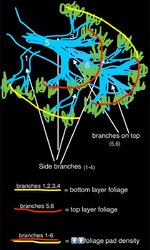D
Deleted member 47471
Guest
Often there is online content (or found in books) suggesting to remove vertically growing foliage on top of a branch. I suppose staggering lateral branches and then wiring the secondaries and tertiaries to rest on top of the primary to create the illusion of pad density (foliage pads resting on top and in the middle of the branch) is possible, but top growth is useful to make a full-bodied pad at a particular place along and on top of a primary branch:


